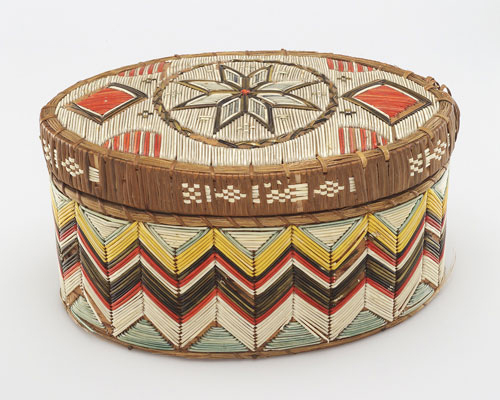Native American Quillwork: Micmac Culture
When I was in grade school, one of our art projects was to collect used wooden matches and then create geometric patterns with them, gluing them side by side on cardboard. It did create an interesting contrast between the burned and unburned ends of the matches, and I actually managed to create stepped patterns with the matches. HOWEVER, looking at this gorgeous object from the Micmac culture of the First Nations, I have no illusions about my future as a competent decorative artist. First Nation cultures are renowned for not wasting any part of animals that they hunt. To me one of the most fascinating art forms to come out of that practice is QUILLWORK.
 |
| Micmac Culture, Covered box, from Maine or Nova Scotia, ca. 1875. Birch bank and porcupine quills colored with aniline dyes, 4 ¼" x 5 1/8" x 8" (10.8 x 13 x 20.3 cm). © Museum of Fine Arts, Boston. (MFAB-491) |
Unlike other Native arts—such as jewelry and weaving of the Navajo, the ledger painting of the Sioux, and the numerous types of trade art that rely on traditional forms—quillwork is one Native art form that has fallen into relative obscurity. Only recently has it been given renewed attention by several First Nation artists (Orvilla Longfox comes to mind). Quilling is an art form that has been done traditionally only by women.
Porcupine quill work is one of the oldest aboriginal art forms. It is a time-consuming and multi-step process. First, the quills must be sorted according to size, cleaned, and dyed. In the traditional manner, the artist would draw the quills repeatedly through her teeth, making them supple. The quills, split in half down the middle, are then applied to the design. They can be arranged in zigzag pattern, plaited, parallel folded, banded, or woven.
The Micmac (Mi'kmaq) arrived in eastern Canada from the north and west during prehistoric times (about 10,000 years ago). They are members of the Algonquis band of First Nations that includes the Abenaki, the Passamaquoddy, the Penobscot, and the Maliseet. They settled in villages along the Atlantic and inland rivers where they fished and hunted for subsistence. They have communities in New Brunswick, Nova Scotia, Prince Edward Island, Newfoundland, Labrador, and Maine.
Like many native bands, the Micmac more or less gave up decorative quillwork with the advent of European glass beads. However, French Canadians called the Micmac “Porcupine Indians” because of their skill at quillwork. This beautiful container is a late example. The quills are set into the birch bark in zigzag patterns with a star pattern on the lid. Birch bark had many uses for the Micmac, including as a covering for their homes, covering on their canoes, and as “callers,” a conical device used for calling over long distances much like a modern megaphone.
This website gives a lot of information about Native quillwork.


Comments